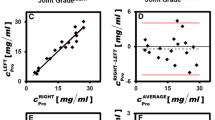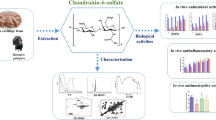Summary
The ability of tannic acid to enhance binding of glycosaminoglycans to purified collagen was analysed in an in vitro system using amino sugar analysis on an amino acid analyser, transmission electron microscopy, and scanning electron microscopy. Collagen was purified by digestion with trypsin, papain, and hyaluronidase. Purified collagen was incubated with hyaluronic acid or with chondroitin sulphate glycosaminoglycan and then treated with tannic acid. Tannic acid was found to enhance retention during preparation for electron microscopy of either of the glycosaminoglycans onto collagen fibres. The ability of tannic acid to enhance binding of collagen and glycosaminoglycans might explain, at least in part, its structural reinforcement effect on resected synovial joint-apposing surfaces during preparation for scanning electron microscopy.
Similar content being viewed by others
References
Bird, C. L. (1977) The dyeing of wool. In The Chemistry of Natural Protein Fibres (edited by Asquith, R.s.), pp. 301–30. New York: Plenum Press.
Boyde, A. & Jones, S. Y. (1983) Scanning electron microscopy of cartilage. In Cartilage. Vol. I Structure, Function and Biochemistry (edited by Hall, B. k.), pp. 105–48. New York: Academic Press.
Burgeson, R. E. (1988) New collagens, new concepts. Ann. Cell Biol. 4, 551–7.
Draenert, Y. & Draenert, K. (1978) Freeze-drying of articular cartilage. Scan. Electron Microsc. II, 759–66.
Enna, C. D. & Zimny, M. (1974) Scanning electron microscopy study of articular cartilage obtained from contracted joints of denervated hands. Hand 6, 65–9.
Farnum, C. E. & Wilsman, N. J. (1986) In situ localization of lectin binding glycosaminoglycans in the matrix of growth plate cartilage. Am. J. Anat. 176, 65–82.
Fithian, D. C., Kelly, M. A. & Mow, V. C. (1990) Material properties and structure-function relationships in the meniscus. Clin. Orthop. 252, 19–31.
Gamliel, H., Gurfel, D., Leizerowitz, R. & Polliak, A. (1983) Air drying of human leukocytes for scanning electron microscopy using the GTGO procedure. J. Microsc. 131, 87–95.
Ghadially, F. N. (1981) Structure and function of articular cartilage. Clin. Rheum. Dis. 7, 3–28.
Ghadially, F. N. (1983) Fine Structure of Synovial Joints. London: Butterworths.
Ghadially, F. N., Ailsby, R. L. & Oryschak, A. T. (1974) Scanning electron microscopy of superficial defects in articular cartilage. Ann. Rheum. Dis. 33, 327–32.
Ghadially, F. N., Ghadially, J. A., Oryschak, A. F. & Yong, N. K. (1977) The surface of dog articular cartilage: a scanning electron microscopy study. J. Anat. 123, 527–36.
Hardingham, T. E. & Muir, H. (1974) Hyaluronic acid in cartilage and proteoglycan aggregation. Biochem. J. 139, 565–81.
Henderson, B. & Edwards, J. C. W. (editors) (1987) The Synovial Lining in Health and Disease, p. 115. London: Chapman & Hall.
Hunziker, E. B. (1991) Tissue sampling and preservation for morphological studies. In Methods in Cartilage Research (edited by Maroudas, A. & Kuettner, K.), pp. 19–25. London: Academic Press.
Kageyama, M., Takagi, M., Parmley, R. T., Toda, M., Hirayama, H. & Toda, Y. (1985) Ultrastructural visualization of the elastic fibres with tannate-metal salt method. Histochem. J. 17, 93–107.
Keene, D. R., Engvall, E. & Glanville, R. W. (1988) Ultrastructure of type VI collagen in human skin and cartilage suggests an anchoring function for the filamentous network. J. Cell Biol. 107, 1995–2006.
Koda, E. & Bernfield, M. (1984) Heparan sulfate proteoglycans from mammary epithelial cells: basal extracellular proteoglycan binds specifically to native type I collagen. J. Biol. Chem. 259, 11 763–70.
Levanon, D. & Stein, H. (1991) The articular cartilage of the rabbit knee: a scanning electron microscopy study. Cells and Materials 1, 219–29.
Levanon, D. & Stein, H. (1992) The synovial lining of the rabbit knee: a scanning electron microscopy study of specimens reinforced with tannic acid. Histochem. J. 24, 25–32.
Levanon, D. & Stein, H. (1993) Evaluation of the use of tannic acid in preparation of the rabbit knee meniscus for scanning electron microscopy. Scanning Microsc. 7, 741–50.
Mcdevitt, C. A. & Muir, H. (1976) Biochemical changes in the cartilage of the knee in experimental and natural osteoarthritis in the dog. J. Bone Joint Surg. (B) 58, 94–101.
Meek, K. M. (1981) The use of glutaraldehyde and tannic acid to preserve reconstituted collagen for electron microscopy. Histochemistry 73, 115–20.
Minns, R. J. & Steven, F. S. (1977) The collagen fibril organization in human articular cartilage. J. Anat. 123, 437–57.
Nation, J. L. (1983) A new method using hexamethyldisilazane for preparation of soft insect tissues for scanning electron microscopy. Stain Technol. 58, 347–51.
Ruggeri, A., Marchini, M., Ottani, V. & Raspanti, M. (1989) Freeze etching as a 3D approach to the collagen fibril structure. Prog. Clin. Biol. Res. 295, 95–100.
Scott, J. E. (1986) Proteoglycan-collagen interactions. In CIBA Foundation Symposium No. 124: Functions of the Proteoglycans, pp. 104–24. New York: John Wiley & Sons.
Scott, J. E. (1988) Proteoglycan-fibrillary collagen interactions. Biochem. J. 252, 313–23.
Scott, J. E. & Orford, C. r. (1981) Dermatan sulphate rich proteoglycan associates with rat tail tendon collagen at the d band in the gap junction. Biochem. J. 197, 213–6.
Scott, P. G., Winterbottom, N., Dodd, C. M., Edwards, E. & Pearson, H. (1986) A role for disulfide bridges in the protein core in the interaction of proteodermatan sulfate and collagen. Biochem. Biophys. Res. Commun. 138, 1348–54.
Sharon, N. (1975) Complex Carbohydrates: Their Chemistry, Biosynthesis and Function, pp. 266–72. Reading, Massachusetts: Addison Wesley Publishing Company.
Simionescu, N. & Simionescu, M. (1976a) Galloylglucoses of low molecular weight as mordant in electron microscopy. I. Procedure, and evidence for mordanting effect. J. Cell Biol. 70, 608–21.
Simionescu, N. & Simionescu, M. (1976b) Galloylglucoses of low molecular weight as mordant in electron microscopy. II. The moiety and functional groups possibly involved in the mordanting effect. J. Cell Biol. 70, 622–33.
Singley, C. T. & Solursh, M. (1980) The use of tannic acid for the ultrastructural visualization of hyaluronic acid. Histochemistry 65, 93–102.
Skutelsky, E. & Roth, J. (1986) Cationic colloidal gold: a new probe for the detection of anionic cell surface sites by electron microscopy. J. Histochem. Cytochem. 34, 693–6.
Steven, F. S. & Thomas, H. (1973) Preparation of insoluble collagen from human cartilage. Biochem. J. 135, 245–7.
Takagi, M. (1990) Ultrastructural cytochemistry of cartilage proteoglycans and their relation to the calcification process. In Ultrastructure of Skeletal Tissues, Bone and Cartilage in Health and Disease (edited by Bonucci, P. & Motta, P. M.), pp. 111–30. London: Kluwer Academic Publishers.
Vaughn, L., Mendler, M., Huber, S., Bruckner, P., Winterhalter, K. H., Irwin, M. I. & Mayer, R. (1988) D-periodic distribution of collagen type IX along cartilage fibrils. J. Cell Biol. 106, 991–7.
Author information
Authors and Affiliations
Rights and permissions
About this article
Cite this article
Levanon, D., Stein, H. Quantitative analysis of chondroitin sulphate retention by tannic acid during preparation of specimens for electron microscopy. Histochem J 27, 457–465 (1995). https://doi.org/10.1007/BF00173711
Received:
Revised:
Issue Date:
DOI: https://doi.org/10.1007/BF00173711




